Table, technical, autochthonous Georgian grape varieties
Georgia is one of the few places where real, autochthonous wild grapes grow. Natural conditions are ideal for the cultivation of many native and introduced varieties. Grape plantations are located in the foothills and plains. Up to 60% of the varieties in Georgia are grown in Kakheti, and the best grapes, according to local residents, grow in the Alazani Valley. In this article we will look at the best Georgian grape varieties.
Table grape varieties of Georgia
Georgia is considered one of the first centers of the emergence of the cultivated vine. The image of grapes is used in religious symbolism, art, architecture, and literature.
There are about 4,000 species of vines known in the world, 525 of them are Georgian, 29 are used for winemaking, 9 are for sale on the market.
The country's soil and climatic conditions are ideal for growing table grapes. However, local winegrowers are not interested in cultivating such varieties. Table grapes no more than 0.5–1 hectares of area were allocated. Manufacturers consider table varieties to be a risky, perishable and not suitable for processing product, so they give preference to technical varieties.
Aladasturi
A red grape variety with 75–77% fruitful shoots. The fruits are used for wine production and fresh consumption. The average weight of a bunch is 200 g.

The ripening period is mid-October. Shelf life: October – March. Productivity - 70–100 c/ha. Transportability is high. Cultivation regions: Ozurgeti, Vani, Chokhatauri, Samtredia.
Tita Kartlis
High-yielding variety with large clusters. The harvest begins in September. The berries are large, long, less often oval, slightly widened in the middle, rounded at the ends. The skin is dense, greenish-yellow, with thick purine. The pulp is fleshy and juicy, the taste and aroma are fruity. The sugar content of the juice is 17–21%, the acid content is 5–8 g/l.
Kartuli Saadreo
Early table variety: 100–120 days pass from the moment the buds open until the fruits are completely ripe. Brushes are medium size, conical, dense. The fruits are round, the skin is thin, light yellow in color, with a waxy coating. The pulp is fleshy and juicy. The average yield is 60–110 c/ha.
Tbilisuri
Late table variety. The ripening period is 175 days. The berries are oval and large. The skin is thick, greenish-yellow, with a golden-bronze blush and light purine. The pulp is fleshy and juicy. The taste is balanced. The average yield is 150–190 c/ha.
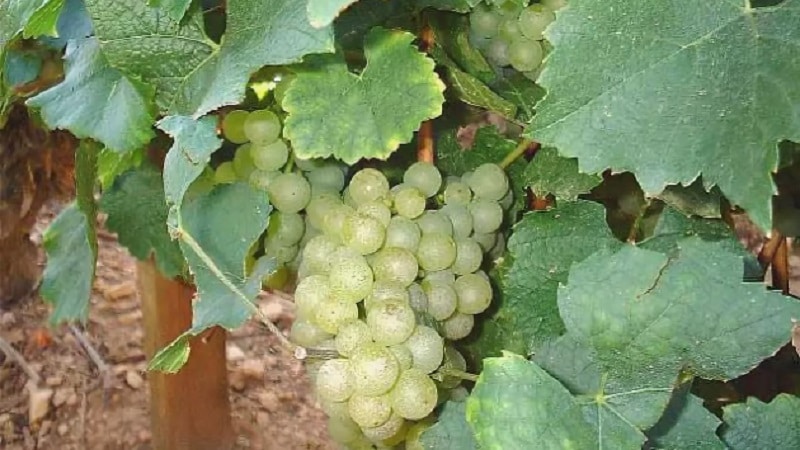
Shasla Tetri
Early table variety. The bunch is dense, conical, medium in size. The berries are round and medium in size. The skin is thin, golden, covered with brown dots. The pulp is juicy, fleshy, the taste is harmonious. Sugar content - 16-17%, acidity - 5.5-5.7 g/l. The average yield is 140–170 c/ha.

Tskhenisdzudzu Apkhazuri
Late ripening table variety. The brushes are large, dense or medium loose. The berries are large, oval. The skin is thick, dark pink. The pulp is slightly juicy and crispy. The fruits are easily separated from the cluster. The taste is sweet, pleasant, the aroma is weak. Sugar content – 17.5–19%, acidity – 7.3–10.4 g/l. The average yield is 150–170 c/ha.
Budeshuri Tsiteli
Best canteen early ripening variety. The clusters are medium-sized, often large, conical, winged and loose. The berries are medium, rarely large, oval, symmetrical, dark pink, but when overripe they turn black.
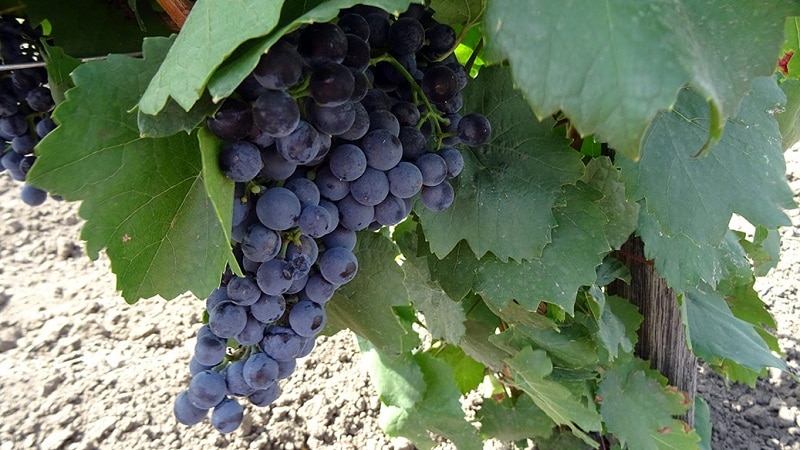
The skin is thick, dense, difficult to separate, and covered with thick purine. The pulp is dense, fleshy. The taste is pleasant, balanced, the aroma is weak.
Reference. In Georgia, the growing period for table grapes lasts from the second half of July to the end of November, which allows for the cultivation of early and very late varieties with high organoleptic qualities.
Productivity - 130–150 c/ha. Sugar content of berries is 17-18%, acidity is 6-7 g/l.
Georgian grape varieties for wine (technical)
Technical varieties intended for the preparation of juices, concentrates, compotes, cognacs, marinades, wines, raisins, currants. This is what winegrowers in the country focus on.
Let's look at the most famous Georgian grape varieties (wine, technical).
Goruli Mtsvane
Mid-late variety of the Black Sea basin. The period of full ripening is 170–180 days. The clusters are medium sized, conical, less often cylindrical, of medium density. The berries are round, the skin is thin, greenish-yellow or yellow, with pink spots. The pulp is fleshy and juicy. The taste is sweet, with a subtle astringent undertone.
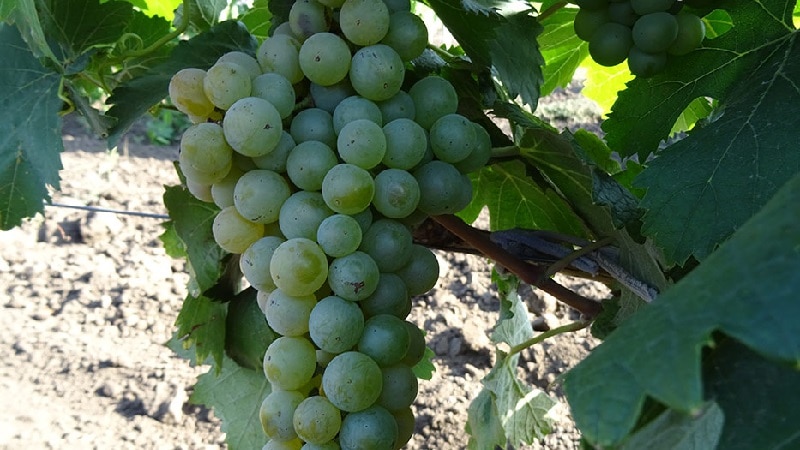
The average yield is 100–110 c/ha. The berries are used to make table white wines, cognac and champagne wine materials.
Dondglabi Shawi
Late variety of the Black Sea basin. The harvest is harvested in early October. The clusters are medium, cylindrical, cylindro-conical and narrow-conical, of medium density. The berries are medium-sized, round and slightly oval. The skin is dense, dark pink, overripe - almost black. The pulp is juicy, the taste is balanced.Productivity is high - 170–190 c/ha. Sugar content - 19-20%, acidity - 10-11 g/l. The fruits are used to make table wines and cognacs.
Ojaleshi
Red wine variety cultivated in the Samegrelo regions. The harvest is harvested in late October - mid-November. The clusters are cylindrical or conical.
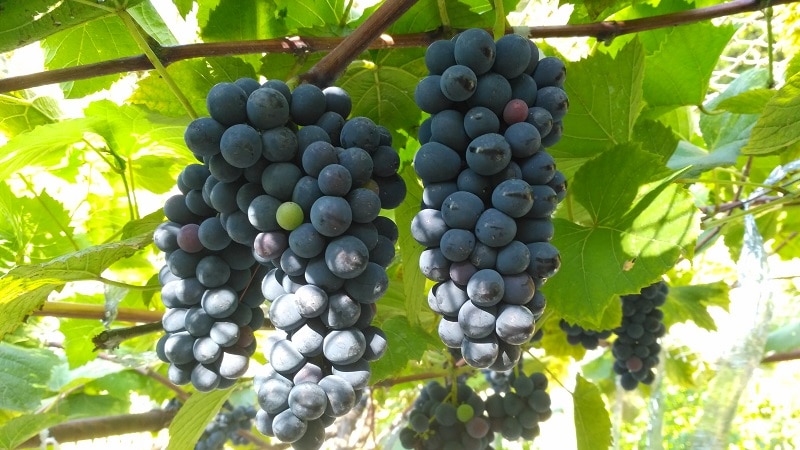
The berries are dark blue in color and have a round or slightly oval shape. Sugar content – 21.2–24.3%, acidity – 7.5–9 g/l. The harvest is used to make dark red original dry or semi-sweet table wines.
Alexandrouli
Mid-late technical variety of the Black Sea basin. The berries are medium-sized, round, black. The skin is thick, dense, the flesh is crispy and juicy. The ripening period is 168 days.
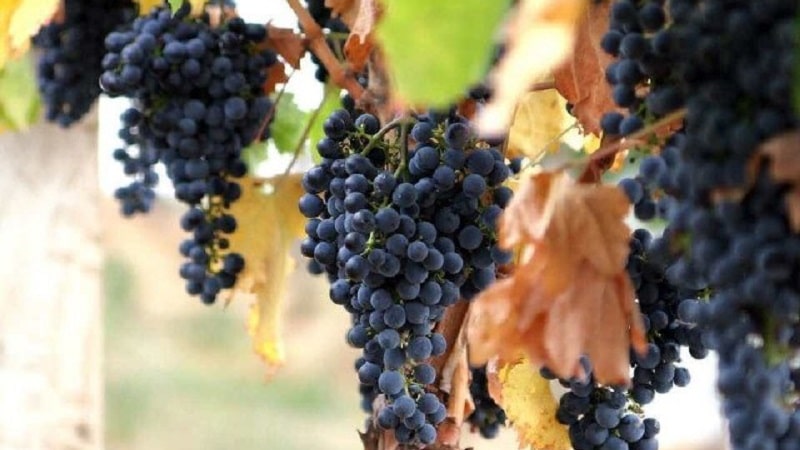
The average yield is 60–70 c/ha. Sugar content - 25-26%, acidity - 5-7 g/l. The fruits are suitable for making dry ordinary table wine “Alexandrouli”, and when blended with Saperavi, original semi-sweet wines are obtained.
Khikhvi
Technical mid-late variety. The clusters are medium-sized, the fruits are greenish-yellow in color with tan spots. The skin is thin, the flesh is crispy and juicy. The harvest ripens in 150 days.
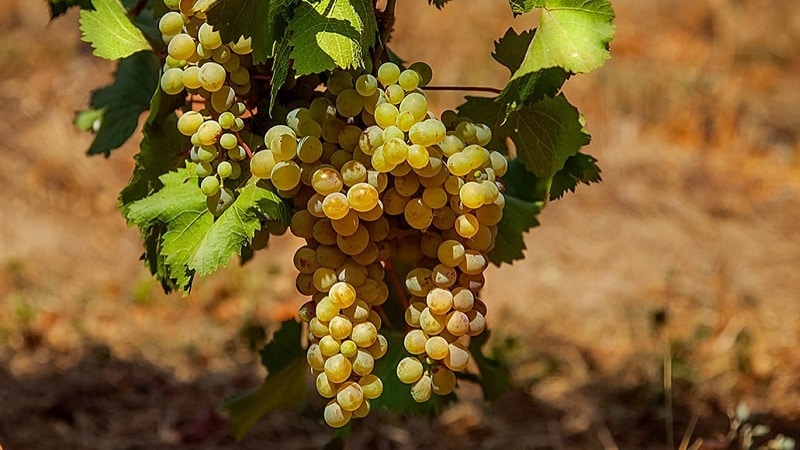
The average yield is 60–90 c/ha. Juice sugar content is 27–29%, acidity is 5–7 g/l. The grapes are used to produce varietal fortified white wine “Khikhvi”, and in a blend with Rkatsiteli and Mtsvane - Kakheti-type wines “Rkatsiteli Khornabujuli”.
Dzelshavi
Late technical variety. The fruits are medium-sized, black or dark red. The pulp is dense and juicy. The harvest is harvested after 170 days. Productivity - 90–145 c/ha. The berries are used to prepare ordinary wine “Dzelshavi”, and in a blend with Cabernet Sauvignon - to produce red sparkling wines.

Chkhaveri
Late technical variety. The clusters are medium-sized, cylindrical, the fruits are medium-sized, dark red in color, the skin is dense, the pulp is juicy. The harvest is harvested after 218 days in November. Sugar content - 22-25%, acidity - 5-7 g/l. The semi-sweet wine “Chkhaveri” is produced from the fruits, and when combined with Rkatsiteli and Chinuri, white sparkling wines are obtained.
Chinuri
A mid-late technical variety of the eastern group. Brushes are cylindrical or cylindrical-conical. The berries are medium in size, greenish-yellow in color with dark red dots. The skin is thin but dense, the flesh is juicy. The ripening period is 166 days.
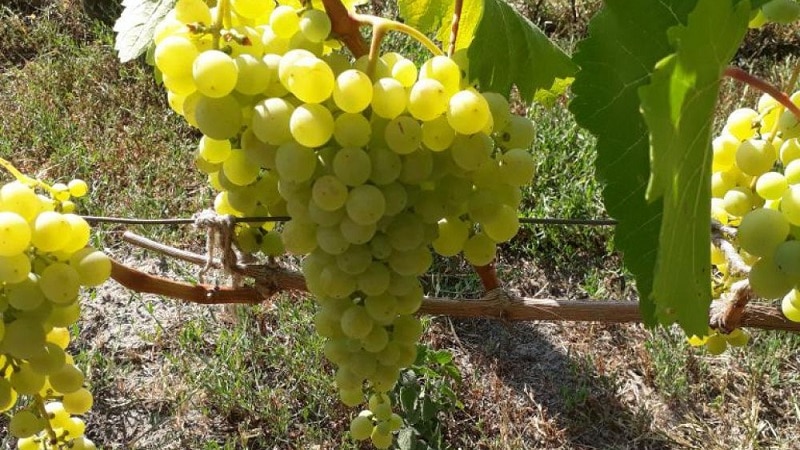
Productivity - 70–80 c/ha. Sugar content - 21-22%, acidity - 8-9 g/l. Table wine of the same name is produced from Chinuri, and when combined with Rkatsiteli and Chkhaveri, excellent white sparkling wines are obtained.
Autochthonous Georgian grape varieties
Aboriginal, or autochthonous varieties belong to a specific area. The term "native" is applied to plants descended from wild species or forms that grew in specific regions. In ancient viticulture regions, varieties were created by selecting wild species or hybrids. The closest connection between native and wild grapes was found in Western Georgia.
There are many autochthonous Georgian varieties: Tsolikouri, Krakhuna, Kudza, Tavkveri, Mujuretuli, Usakhelouri, Chkhaveri, Shavkapito, Kapiston Shavi, Chumuta, Jani, Paneshi, Kachichi, Budeshuri Tsiteli. However, the most famous of them are Kisi, Saperavi, Rkatsiteli, Mtsvane and Tsitska.
Kisi
Autochthonous white grapes, part of the group of Kakheti varieties. The fruits are used for the production of European, traditional Kakheti, natural semi-sweet, fortified and dessert wines.The wine, made using the European method, has a light straw color, a pleasant varietal aroma and a delicate harmonious taste. Kakheti wines are darker and full-bodied, with a rich and complex taste and fruity aroma. When blended with Rkatsiteli, the result is a bright, rich drink.
Kisi grapes from Georgia are medium technical. The sugar content of the juice is 20–22%, acidity is 7.5–8.5 g/l. The clusters are medium in size, conical or cylindrical-conical in shape. The berries are medium-sized, oval, the skin is thin, greenish-yellow, the pulp is juicy. The fruit ripening period is 140 days. Productivity - 50–80 c/ha.
The vineyards are concentrated in the foothills of the Akhmeta region.
Saperavi
The main autochthonous red grape variety, characterized by high yield and unpretentiousness. It produces various high quality wines: "Kindzmarauli", “Akhasheni”, “Mukuzani”.
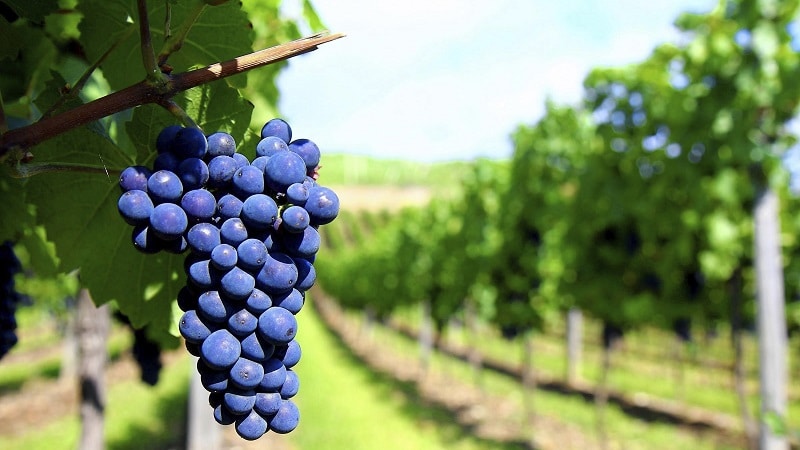
Translated from Georgian, the name of the variety means “dyer”. Dark fruits They contain a lot of coloring substances, which is why the reddest wines are made from them. The berries even have pink juice, which is not typical for black varieties.
Table wine from the Saperavi variety has an intensely dark color, is characterized by moderate alcohol and acid content, a rich bouquet and high taste. Wines from Saperavi age slowly and retain their organoleptic properties for up to 50 years. Experts recommend consuming them after four years of aging.
Plantings occupy more than 4000 hectares. The harvest is harvested in the second half of September - mid-October. Sugar content of juice is 20–26%, acidity is 7.4–8.5 g/l.
Reference. Saperavi is used to produce many wines: “Akhasheni”, “Kvareli”, “Kotekhi”, “Kindzmarauli”, “Tbilisuri”, “Pirosmani”, “Alazani”.
Wines from Saperavi are dry, semi-sweet, sweet or fortified. The variety is suitable for the production of drinks using traditional and European methods. The wort is aged in French, Slovenian, American, Hungarian, and Russian oak. The finished product is inky, often cloudy, with the aroma of licorice, spices, berries, tobacco, fried meat, and chocolate. The texture is juicy and astringent, with a slight sourness. Alcohol content: 12–14%.
The aroma depends on the terroir:
- cool regions produce elegant wines with the aroma of red berries;
- Warm areas away from the mountains produce wines with fruity notes and high alcohol content.
Rkatsiteli
White autochthonous Georgian grape variety is used to produce white wine. Rkatsiteli is distinguished by its high yield; it is cultivated in huge quantities mainly in Kakheti, less so in Kartli. In many other countries, wines from this variety have a sour taste, but not in Georgia. The local climate is ideal for growing Rkatsiteli. Especially delicious grapes It turns out near the village of Tsinandali near Telavi.
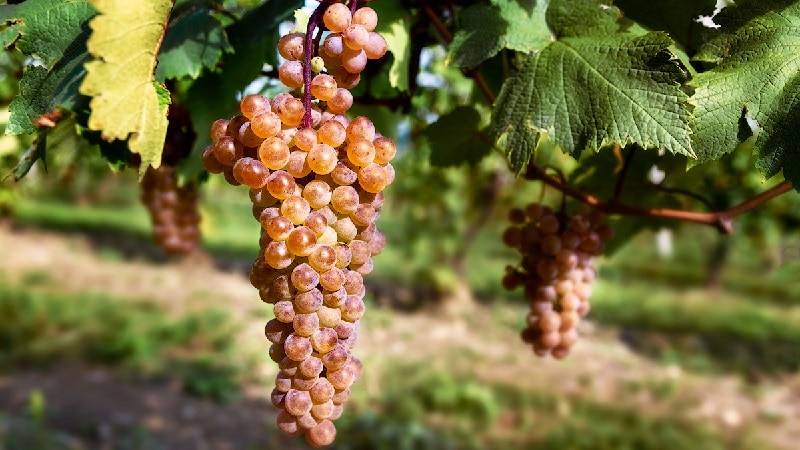
Rkatsiteli is a medium or late medium technical variety that fully ripens in mid-September in Kakheti and in early October in Kartli. Sugar content of berries is 20–24%, acidity is 7-8 g/l.
The berries are medium in size, oval in shape, the skin is thin, golden yellow, with brown spots. The pulp is juicy. The ripening period is 150 days. Productivity - 110–160 c/ha. The variety is characterized by medium growth vigor.
Famous white wines are produced from Rkatsiteli using Kakheti and European technologies, without using Imeretian technology.From grapes of this variety, wines are produced indicating the place of origin: “Kotekhi”, “Tsinandali”, “Kardenakhi”, “Gurjaani”, “Kakheti”, “Vazisubani”, “Napareuli”, “Tibaani”, port wine “Kardanakhi” and Madeira “ Khirsa."
Mtsvane
There are two varieties of Mtsvane: Kakhuri and Goruli. Mtsvane means “green” in Georgian. The berries are uniformly green in color. The wines are light, slightly sour, with a complex fruity aroma, reminiscent of European whites. Mtsvane Kakhuri is used for blending with Rkatsiteli. The result of this merger was the Tsinandali wine.

The vineyards are located in Kakheti, near Tbilisi, where the white wine Manavis Mtsvane is produced.
Mtsvane Kakhuri is winter-hardy and does not tolerate drought well. Included in the group of Kakheti grape varieties. Harvesting begins in the second half of September.
In Georgia they believe that the best Mtsvane is cultivated in the village of Manavi. Wine is made from grapes using European and Kakheti technologies. The wine, made using the European method, has a greenish-straw color, has a harmonious and lively taste, and is enriched with fruity tones. The drink obtained using Kakhetian technology is brighter, more energetic, and when aged it acquires a strong fruity aroma.
Mtsvane Kakhuri is used to produce wines indicating the place of origin: “Manavi”, “Vazisubani”, “Kardenakhi”, “Tsinandali”, “Kakheti”.
Mtsvane Goruli is grown mainly in Kartli. The berries produce high-quality products. The wine turns out lively and energetic. In the Kartli regions, the variety is used as a blending material for the production of sparkling wines.
Goruli ripens late: mid-October - early November. The sugar content of the juice is 21.5–23%, acidity is 9-10 g/l.Wine ages slowly. Goruli Mtsvane, when blended with Chinuri, produces white sparkling wine “Ateni”.
Tsitska
Tsitska is an autochthonous white grape from Imereti. Table wine has a light straw color with a greenish tint and has an energetic, lively, harmonious taste. Aged products acquire a pleasant bouquet and plant tones.
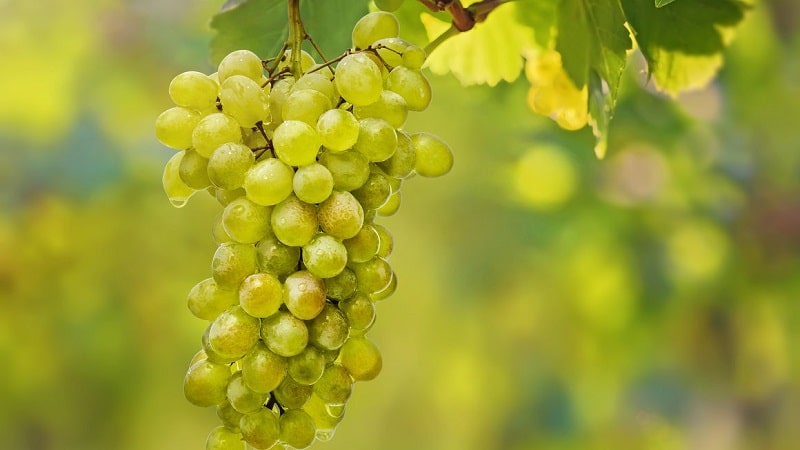
Tsitska is a late technical variety. Harvesting begins in the second half of October. Sugar content of juice is 18–25%, acidity is 7–10 g/l. The clusters are medium-sized, cylindrical or conical in shape, dense. The berries are medium round or slightly oval, greenish-yellow, covered with a thick waxy coating. The pulp is juicy, crispy, the taste is harmonious. The skin is thin but durable. Productivity is high: 150–170 c/ha.
Tsitska is also used to make sparkling wines. When blended with Tsolikouri, a dry white wine is obtained with the name “Sviri” based on its place of origin.
Vineyards and grape plantations of Georgia
The natural conditions of Georgia create a favorable environment for viticulture. The country is divided into the following zones:
- Kakheti is the main wine-growing region of Georgia;
- Kartli, in which the microzones of Kvemo Kartli, Shida Kartli, Zemo Kartli are identified;
- Meskheti;
- Imereti with the Svir microzone;
- Racha-Lechkhumi with the Khvanchkara microzone, in the Lechkhumi region the Tvishi and Usakhelauri microzones are distinguished.
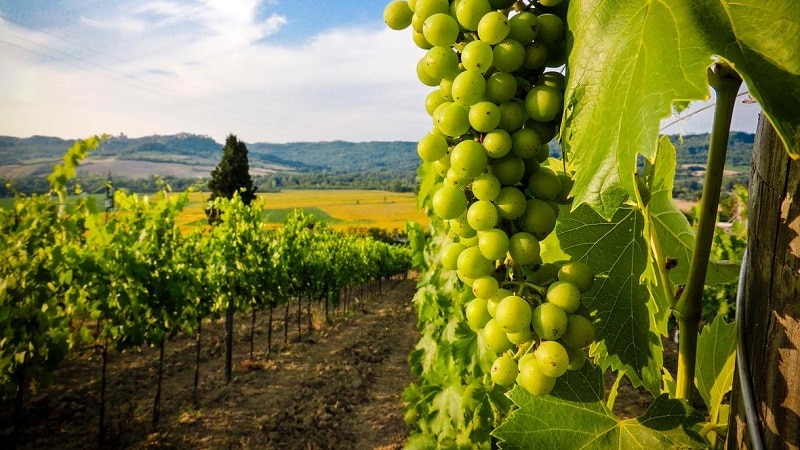
Traditionally, wines are named after the area where the grapes are grown. Up to 65–70% of plantations are located in the Kakheti region, which is divided into 25 microzones. The varieties Napareuli, Tsinandali, and Gurjaani are cultivated here.
The best varieties are grown in the Alazani Valley, at an altitude of 400–700 m above sea level. They are used to produce table red and white, dry, sweet and dessert wines.
Adjara is a region in the southwestern part of Georgia.The hot and humid subtropical climate favors the cultivation of plants with a long growing season. Traditional Adjarian wines are “Saturavi”, “Khopatushi”, “Klarjuli”, “Mekranchi”, “Shavshura”.
Other vineyards in Georgia cultivate varieties suitable for the production of dry red and white table wines.
Conclusion
In Georgia they grow mainly technical grape varieties. Canteens are less popular: their cultivation is considered economically unprofitable. The most famous table varieties with excellent taste: Aladasturi, Tita Kartlis, Kartuli Saadreo, Tbilisuri, Shasla Tetri, Tskhenisdzudzu Apkhazuri, Budeshuri Tsiteli.
Technical varieties are used for the production of table white, dry red, sweet, semi-sweet, fortified wines, port, cognac and sparkling wines. The most famous of them are Goruli Mtsvane, Dondglabi Shavi, Ojaleshi, Aleksandrouli, Khikhvi, Dzelshavi, Chkhaveri, Chinuri.
Autochthonous plants belong to a specific area and are descended from wild species or forms. The most popular: Kisi, Saperavi, Mtsvane Kakhuri and Goruli, Rkatsiteli and Tsitska.
What is known about the Georgian dark grape variety UTSAMLI?